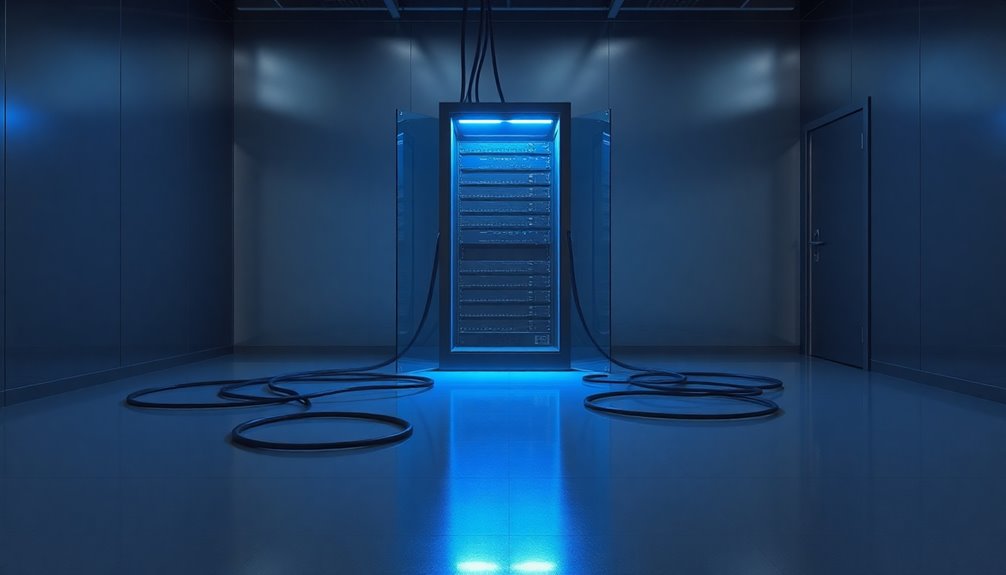An air-gapped network is a cybersecurity measure that physically separates critical systems from unsecured networks, like the Internet. You'll find these networks in high-security environments, such as government and military settings. Access to these systems is strictly controlled, allowing only authorized personnel to interact with them. Data transfer often involves removable media, ensuring that only vetted information is introduced. This isolation significantly reduces the risk of unauthorized access and malware. However, keep in mind the potential challenges it poses, as you may discover more nuances surrounding air-gapped security strategies and emerging technologies.
Key Takeaways
- Air-gapped networks are physically isolated systems that prevent unauthorized access from unsecured networks like the Internet.
- They utilize strict access controls and unidirectional data flow to protect sensitive data from external threats.
- Data transfer typically occurs via removable media, necessitating manual processes to control security risks.
- Air-gapped networks significantly reduce the risk of malware and data exfiltration, making them ideal for high-security environments.
- Regular audits and security assessments are essential for maintaining the integrity of air-gapped systems against evolving cyber threats.
Fundamental Principles of Isolation

When it comes to securing sensitive information, air-gapped networks stand out because they rely on physical isolation. This means your critical systems are completely disconnected from unsecured networks, including the Internet.
By enforcing strict controls around access points, only authorized personnel can interact with these systems. Unidirectional data flow plays a key role here; data diodes allow information to flow into the air-gapped network while blocking any outbound transmission.
This significantly minimizes potential attack vectors, reducing the risk of unauthorized access and malware propagation. Implementing robust security measures and conducting regular audits are essential to maintain the integrity of these networks and ensure that physical isolation remains effective against evolving cyber threats.
Significance in Cybersecurity Strategy

Given the rising sophistication of cyber threats, air-gapped networks play a crucial role in a robust cybersecurity strategy.
These networks physically isolate sensitive systems from unsecured networks, significantly reducing the risk of unauthorized access and data exfiltration. With 92% of ransomware attacks targeting various industries, the need for such isolation strategies has never been more critical.
Air-gapped systems maintain the integrity of critical data by preventing direct internet connectivity, which is essential for sectors like government, finance, and healthcare.
However, it's vital to conduct ongoing security assessments to adapt to emerging threats. By integrating air-gapped networks into your comprehensive cybersecurity strategy, you can bolster defenses against malware and protect sensitive information effectively.
Data Transmission Barriers Established

Air-gapped networks create a formidable line of defense against cyber threats by establishing strict data transmission barriers.
By employing physical isolation, these networks prevent unauthorized access and shield sensitive information from potential breaches.
Data transfer in air-gapped environments relies on removable media like USB drives, necessitating controlled manual processes to ensure security.
You'll find that stringent protocols govern this transmission, minimizing risks associated with human error and malware introduction.
Without internet connectivity, software and data updates must be done manually, ensuring only vetted, secure data enters the isolated system.
Additionally, organizations bolster these data transmission barriers with encryption and access controls, further protecting their critical assets from potential vulnerabilities.
Pros and Cons Summary

While air-gapped networks offer robust security benefits, they come with notable drawbacks. These systems enhance physical security by isolating sensitive data from unauthorized access, significantly reducing cyber threats.
However, they aren't foolproof; sophisticated malware can still be introduced through physical media, leading to potential data breaches. The operational complexity of air-gapped networks means data transfer often relies on manual updates, which can create vulnerabilities if software becomes outdated.
Additionally, insider threats pose a risk since authorized personnel might unintentionally or maliciously compromise security. Lastly, the reliance on manual processes can slow down workflows and limit functionality, making it essential to weigh these pros and cons when considering air-gapped solutions.
Air Gaps Versus VPNS

When considering security solutions, understanding the differences between air gaps and VPNs is crucial for making informed decisions.
Air gaps provide physical isolation from external networks, making them ideal for high-security environments like military and government operations. This isolation protects sensitive information from cyber threats, as data transfer typically requires physical media like USB drives.
On the other hand, VPNs create encrypted tunnels over existing networks, allowing secure remote access and continuous data flow. However, VPNs can be vulnerable to attacks if not properly configured, increasing the risk of exposure.
While both aim to enhance security, air gaps offer a more stringent protective measure, whereas VPNs provide flexibility and convenience for corporate settings.
Insider Threat Vulnerabilities

Even with the highest levels of physical security, air-gapped networks aren't immune to insider threats. Authorized personnel can unintentionally or intentionally introduce malware through infected removable media, compromising sensitive systems.
The 2022 Cybersecurity Insider Threat Report reveals over 60% of organizations faced such incidents, underscoring the need for robust monitoring and access controls. Insider threats can lead to severe data breaches, costing around $11.45 million per event.
To mitigate these risks, implementing strict access controls and conducting routine audits are crucial. Regular security training emphasizes adhering to strict protocols during data transfers, helping minimize vulnerabilities. Additionally, community engagement through sharing experiences and advice can enhance awareness of potential insider risks.
Emerging Air Gap Technologies

As organizations seek to enhance the security of air-gapped environments, emerging technologies are paving the way for safer data transfer methods. Innovations like unidirectional data diodes enable secure data transfer by allowing data to flow from a secure network to an air-gapped system without reverse communication.
Researchers are also exploring optical air gaps, utilizing light for isolated systems. Advanced malware detection systems, employing machine learning algorithms, proactively identify threats targeting these networks.
Integrating physical security measures, such as biometric access controls, helps protect against insider threats. Additionally, ongoing research into covert communication techniques reveals the necessity for enhanced monitoring to detect breaches, particularly those using thermal or acoustic signaling, ensuring robust air gap security.
Regularly Audit Physical Access

Regular audits of physical access to air-gapped systems are essential for maintaining security and identifying potential vulnerabilities. By establishing a schedule for regular audits, you can ensure compliance with security protocols and uncover unauthorized personnel trying to breach your defenses.
Meticulously maintaining and reviewing access logs helps track who enters and exits, enhancing accountability and aiding incident investigations. Implementing strict access controls, like badge systems and biometric authentication, bolsters the effectiveness of your audits.
Moreover, continuous training for security personnel is crucial; they need to recognize and respond swiftly to physical security breaches. By prioritizing these measures, you'll significantly strengthen the protection of your air-gapped environments against potential threats.
Frequently Asked Questions
What Does It Mean if a System Is Air-Gapped?
If a system's air-gapped, it means it's physically isolated from unsecured networks, like the Internet. You can't access it remotely, which helps protect sensitive information from cyber threats.
To transfer data, you'd typically use physical media, like USB drives, making the process more labor-intensive.
While this setup enhances security, you still need to be cautious, as risks like malware can enter through infected devices, so ongoing monitoring is essential.
What Are the Benefits of Air Gapping?
When you consider air gapping, you're looking at significant benefits for your organization.
It enhances security by isolating critical systems from unsecured networks, drastically lowering the risk of unauthorized access.
You'll protect sensitive data from malware and ransomware, maintaining the integrity of your backup systems.
This physical separation complicates attacks, acting as a strong deterrent against sophisticated threats.
What Is the Purpose of an Air Gap?
The purpose of an air gap is to create a physical separation between a secure network and potentially insecure networks, like the Internet.
You're minimizing the risk of unauthorized access and protecting sensitive data from cyber threats.
By requiring manual data transfers, you help prevent malware infiltration and ensure that critical information remains confidential.
This isolation is essential for maintaining the integrity of systems in high-security environments, safeguarding vital data from external vulnerabilities.
What Is the Air Gap Technique?
The air gap technique involves isolating a computer or network from unsecured networks, like the Internet, to enhance security.
You physically separate systems to prevent unauthorized access to sensitive data. Data transfer is done manually, using physical media, which reduces the risk of cyber threats.
While this method is effective, you must remain vigilant, as advanced malware could still exploit vulnerabilities.
Regular assessments and strict access controls are crucial to maintaining security.
Conclusion
In conclusion, air-gapping is a crucial strategy for protecting sensitive information by creating a physical barrier between systems. While it offers significant advantages in cybersecurity, it's essential to remain aware of the potential insider threats that can compromise even the most isolated setups. Regular audits of physical access and staying updated on emerging technologies can further enhance your security posture. Balancing air gaps with other measures, like VPNs, can lead to a more robust defense against cyber threats.









